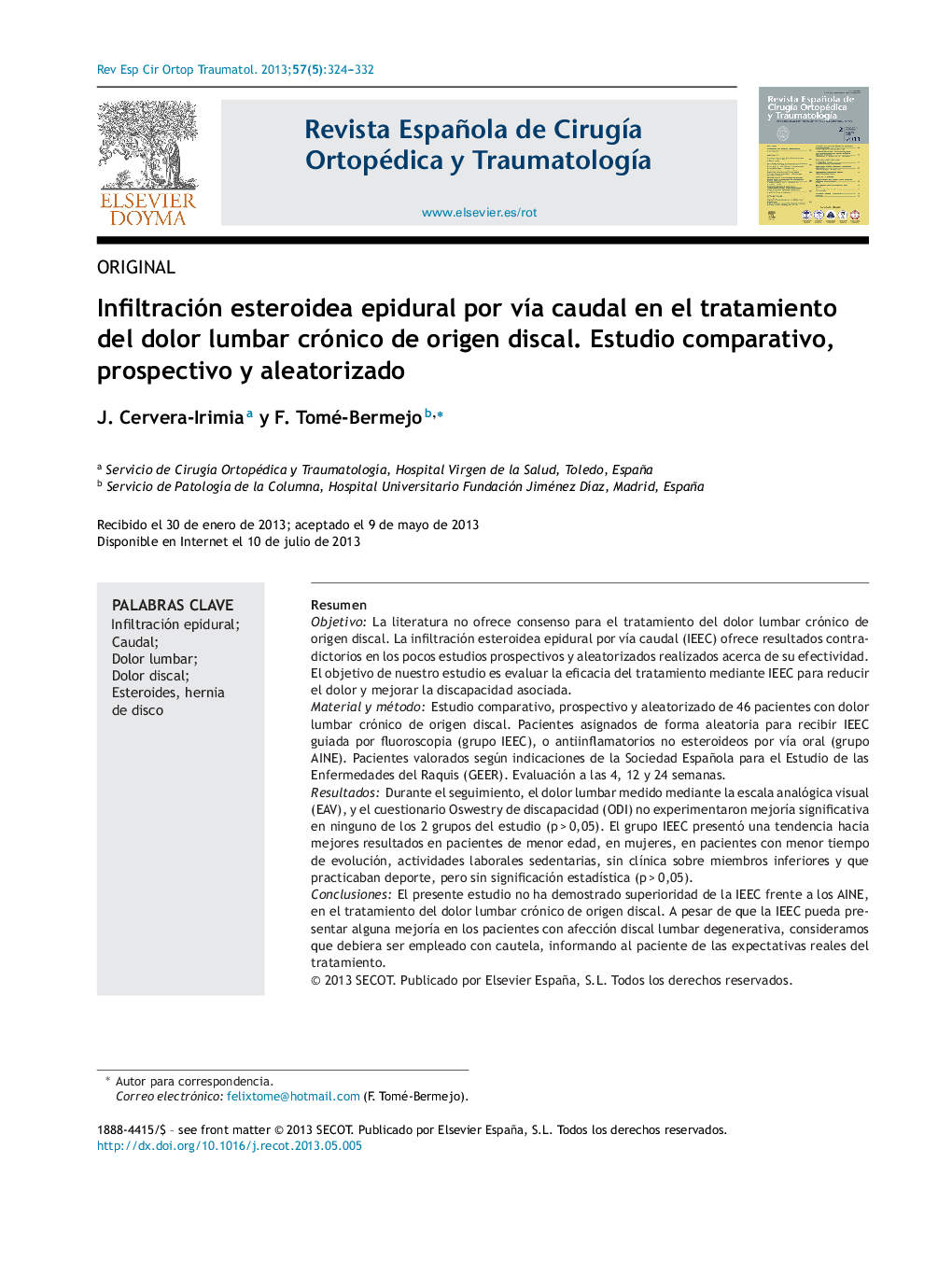| Article ID | Journal | Published Year | Pages | File Type |
|---|---|---|---|---|
| 4086253 | Revista Española de Cirugía Ortopédica y Traumatología | 2013 | 9 Pages |
ResumenObjetivoLa literatura no ofrece consenso para el tratamiento del dolor lumbar crónico de origen discal. La infiltración esteroidea epidural por vía caudal (IEEC) ofrece resultados contradictorios en los pocos estudios prospectivos y aleatorizados realizados acerca de su efectividad. El objetivo de nuestro estudio es evaluar la eficacia del tratamiento mediante IEEC para reducir el dolor y mejorar la discapacidad asociada.Material y métodoEstudio comparativo, prospectivo y aleatorizado de 46 pacientes con dolor lumbar crónico de origen discal. Pacientes asignados de forma aleatoria para recibir IEEC guiada por fluoroscopia (grupo IEEC), o antiinflamatorios no esteroideos por vía oral (grupo AINE). Pacientes valorados según indicaciones de la Sociedad Española para el Estudio de las Enfermedades del Raquis (GEER). Evaluación a las 4, 12 y 24 semanas.ResultadosDurante el seguimiento, el dolor lumbar medido mediante la escala analógica visual (EAV), y el cuestionario Oswestry de discapacidad (ODI) no experimentaron mejoría significativa en ninguno de los 2 grupos del estudio (p > 0,05). El grupo IEEC presentó una tendencia hacia mejores resultados en pacientes de menor edad, en mujeres, en pacientes con menor tiempo de evolución, actividades laborales sedentarias, sin clínica sobre miembros inferiores y que practicaban deporte, pero sin significación estadística (p > 0,05).ConclusionesEl presente estudio no ha demostrado superioridad de la IEEC frente a los AINE, en el tratamiento del dolor lumbar crónico de origen discal. A pesar de que la IEEC pueda presentar alguna mejoría en los pacientes con afección discal lumbar degenerativa, consideramos que debiera ser empleado con cautela, informando al paciente de las expectativas reales del tratamiento.
ObjectiveThere is no consensus on the treatment of chronic low back pain of disc origin in the medical literature. The few prospective, randomized, controlled studies evaluating the effectiveness of caudal epidural steroid injections (CESI) have obtained contradictory results. The aim of this study is to evaluate the efficacy of CEI in reducing pain and improving the associated disability.Material and methodThis is a prospective, randomized, case-control study of a group of 46 patients with chronic low back disc pain. Patients were randomly allocated into 2 groups to either receive fluoroscopy guided CESI (CESI-group), or oral non-steroidal anti-inflammatory drugs (NSAID-group). All patients were clinically evaluated at 4, 12, and 24 weeks, and according to the indications of the Spanish Society for Study of Diseases of the Spine (GEER).ResultsLumbar pain, measured by the visual analog scale (VAS) and the Oswestry Low Back Pain Disability Questionnaire (ODQ), did not improve significantly during follow-up in any of the two study groups (P>.05). Younger patients, women, patients with shorter duration of symptoms, low physical job demand, without leg pain, and sport-active, included in CESI-group showed a trend towards better results, but none reached statistical significance (P>.05).ConclusionsThe present study has not demonstrated the superiority of CESI over NSAIDs in treating chronic low back pain of disc origin. While CESI could show some improvement in patients with degenerative lumbar disc disease, we consider it should be used with caution, informing patients about realistic expectations on the success of treatment.
